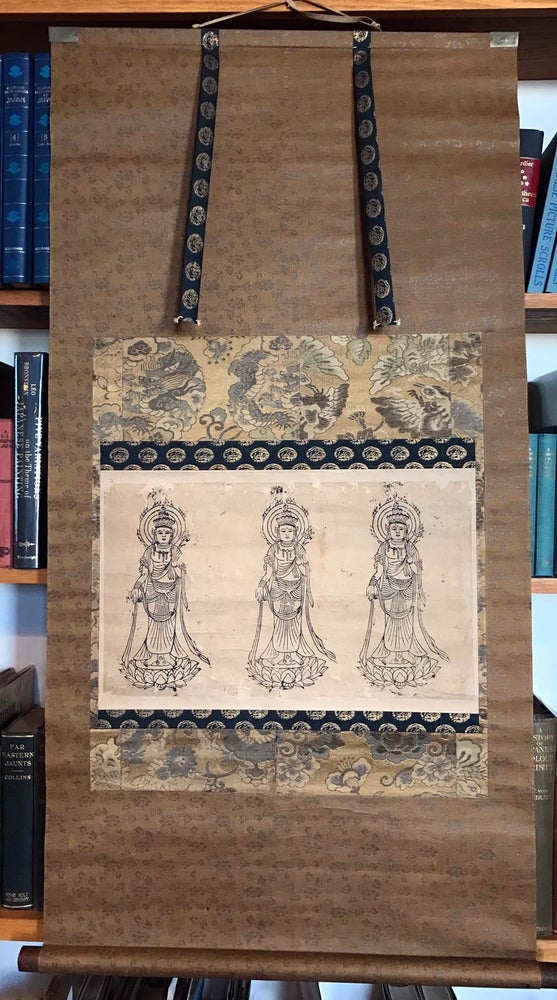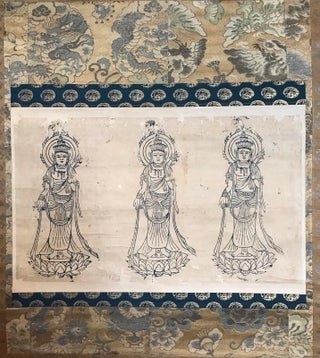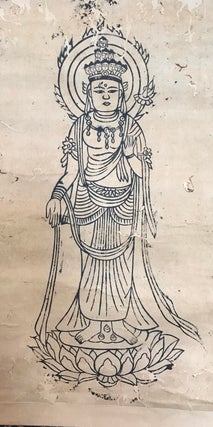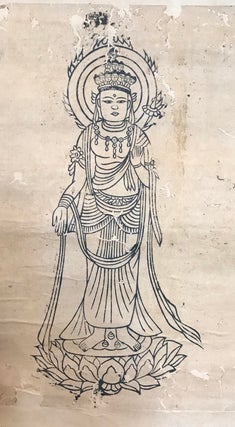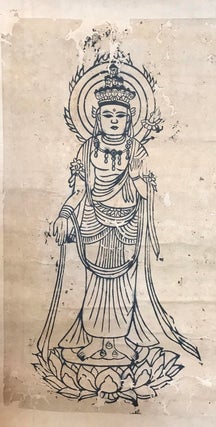Suribotoke of Standing 11-Faced Kannon, late 12th Early 13th Century.
11. Item #89649
[Early Printing] Hōryūji Temple 法隆寺
Suribotoke of Standing 11-Faced Kannon, late 12th Early 13th Century.
[Early Printing] Hōryūji Temple 法隆寺. Suribotoke of Standing 11-Faced Kannon, late 12th Early 13th Century. Single sheet woodblock printed suribotoke 摺仏 of 3 standing Kannon 観音 figures, printed from a hangi 版木 woodblock, mounted as a hanging scroll (kakemono 掛物), probably in the late 19th century. Each figure is about 23.2 centimeters tall. Records indicate that the original sheets had as many as 5 figures printed across the sheet. Hōryūji Temple 法隆寺, founded by Prince Shōtoku 聖徳太子 (Shōtoku Taishi 574-627) in Nara 奈良 in the early 7th century, is one of the original Buddhist temples of Japan. The Hōryūji complex was built, rebuilt and added to over the centuries and remains perhaps the most amazing repository of classical Japanese culture in existence. The printed 11-Faced Kannon images at hand were placed in the base of an important statue of Bonten Taishakuten 梵天 帝釈天 located in the Sangyoin 三経院 [The Hall of the Three Sutras] study hall. There appears to be some controversy as to whether these printed inbutsu 印仏 were created in the late Heian平安 or the early Kamakura鎌倉 era - the late 12th or early 13th century. I would refer you to the cover images and description of this inbutsu from an exhibition held at the Hamamatsu City Art Museum (Hamamatsu Bijutsukan 浜松市美術館) on Buddhist printing in 1974 and the Nihon no Bijutsu 日本の美術 issue dedicated to Buddhist art, published in 1984. (Included with the scroll). Either dating is early - not quite as early as the Amida 阿弥陀 figures from Hōryūji, but these larger images are aesthetically remarkable and illustrate the high state of culture, even in the midst of the warfare that marked the end of Heian. It might be noted that the end of the Heian era and the civil war that presaged it were probably viewed by contemporary observers as symptoms of the beginning of Mappō 末法, predicted to start in 1052. Mappo was the degenerate age during which only an appeal to the merciful Amida Buddha 阿弥陀 and his assistant Kannon could help one to Paradise, as individual efforts towards enlightenment were fruitless. The traditional mounting of the sheet as a kakemono hanging scroll 掛物, along with the lovely lacquered jiku 軸 handles, is expert and the materials used are appropriate and lovely. Probably done during the Meiji period, it is in very good condition still. Important both for the history of Buddhist art and the world history of illustration, as well.
Price: $9,500.00

